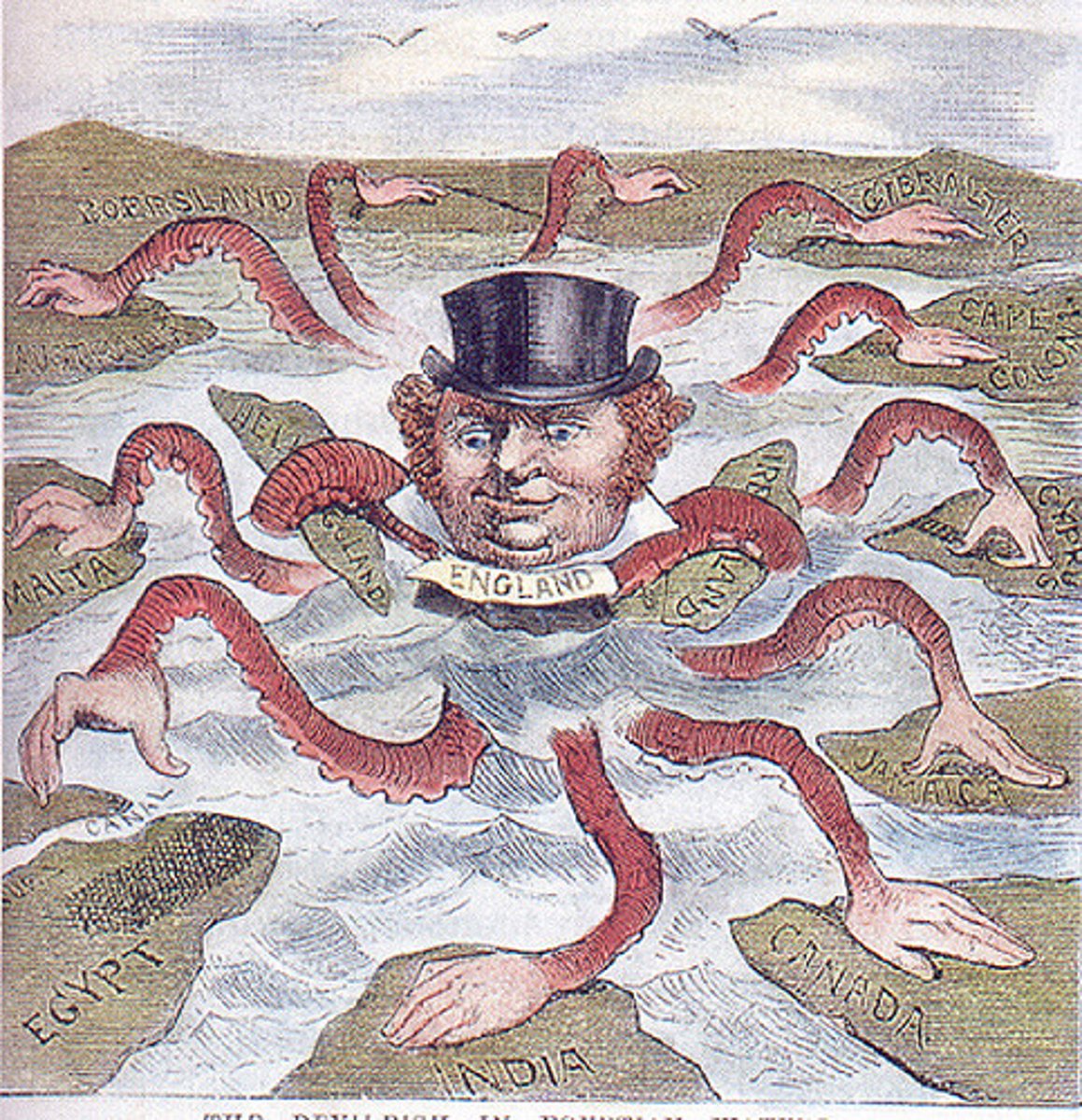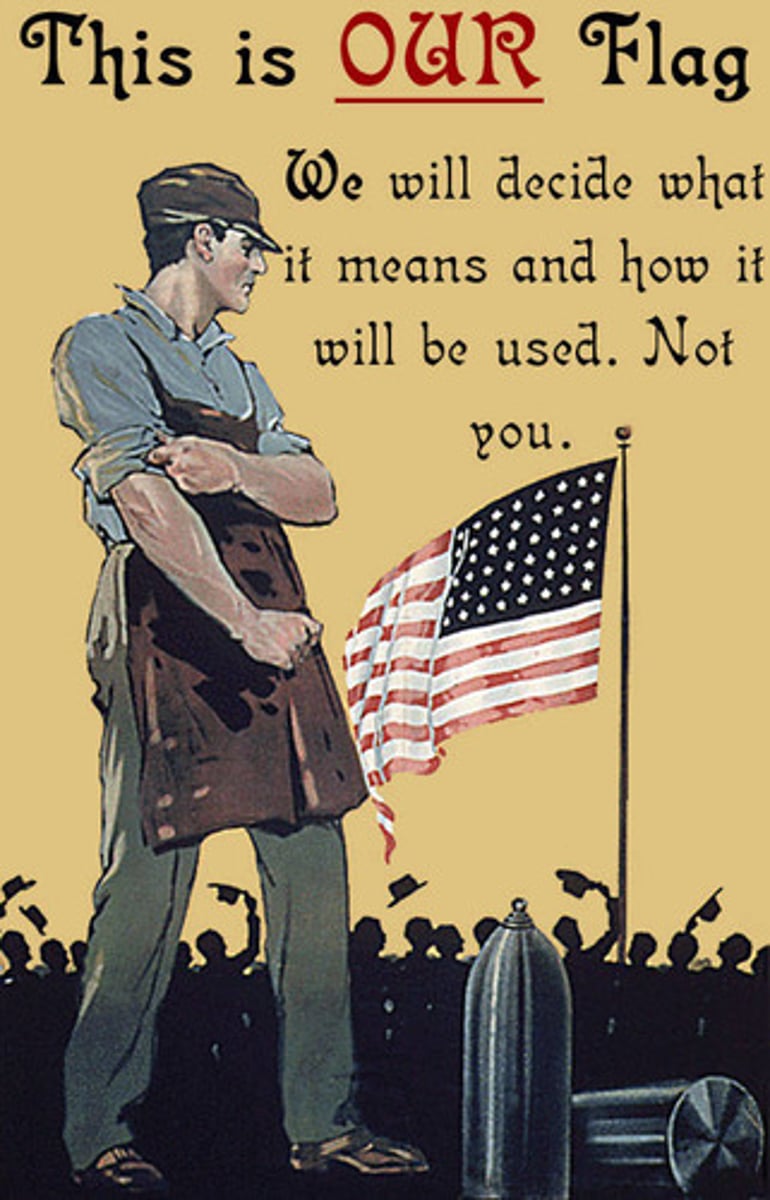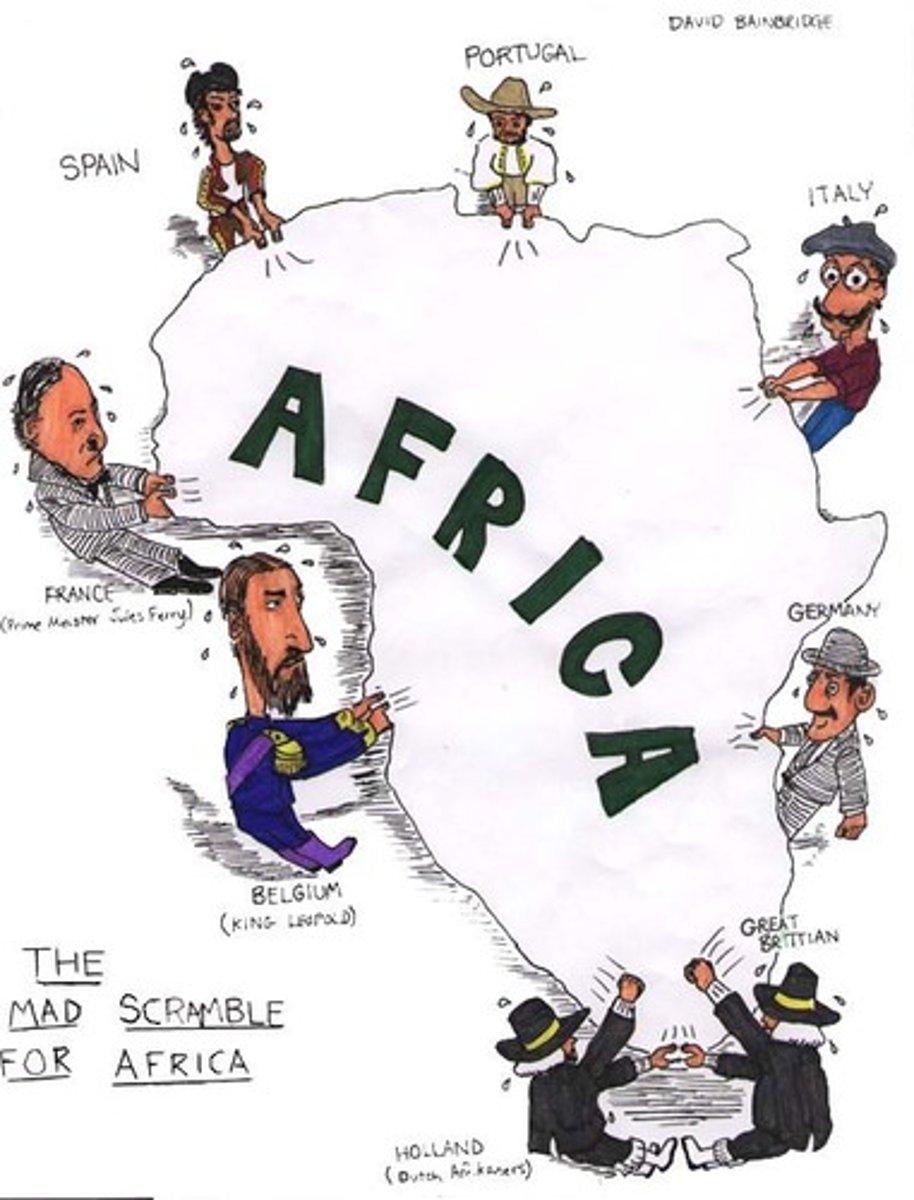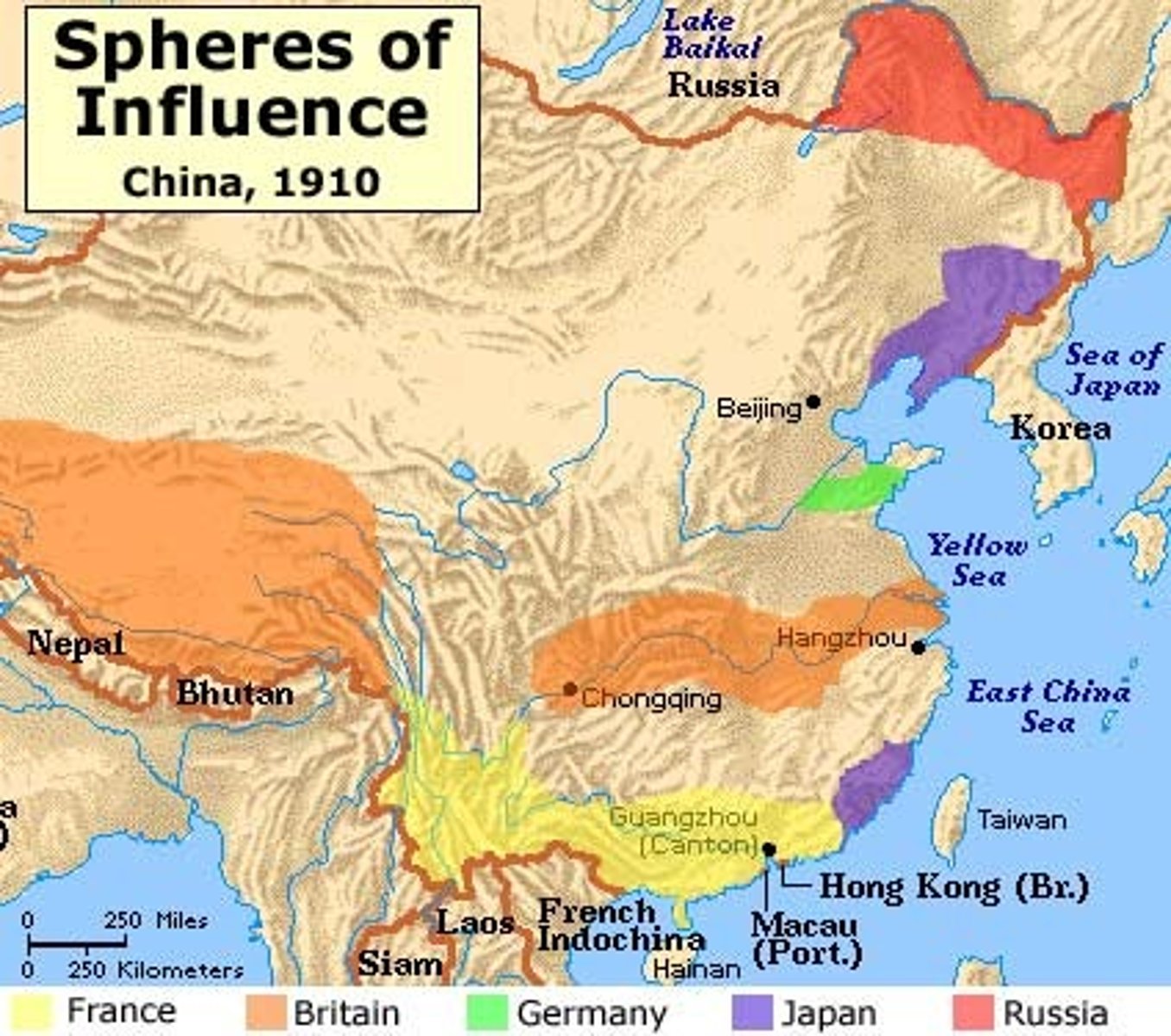Unit 6: Consequences of Industrialization
1/51
There's no tags or description
Looks like no tags are added yet.
Name | Mastery | Learn | Test | Matching | Spaced |
|---|
No study sessions yet.
52 Terms
Imperialism
A policy of extending a country's power and influence through diplomacy or military force.

Social Darwinism
The belief that only the fittest survive in human political and economic struggle.

Nationalism
A strong feeling of pride in and devotion to one's country

Civilizing missions (significance)
accompanied the notion of Social Darwinism and perpetuated the view of natives as "lazy" or "heathens; suppressed "native customs" that ran counter to Western ways of living in exchange for European values that were defined as "progress"
Japanese colonial expansion
Victories over China and Russia expanded the Japanese sphere of influence, notably in Taiwan and Korea, and southern Sakhalin became a colony of Japan as the Karafuto Prefecture in 1905.
Russian expansion
While Italy was unifying, Russia's emperors had been extending their control eastward toward the Pacific. Traders and settlers in Siberia, said to be around 0.9 million in 1800, had increased to 2.7 million by 1850, most of them in the western part of Siberia.
Berlin conference
A meeting from 1884-1885 at which representatives of European nations agreed on rules colonization of Africa

Anti-imperialism
belief that the U.S. should not expand its territory overseas and that the U.S. should just be a normal country and leave the other countries alone
Tupac Amaru II
Member of Inca aristocracy who led a rebellion against Spanish authorities in Peru in 1780-1781. He was captured and executed with his wife and other members of his family.
Samory Toure
leader of Malinke peoples in West Africa who formed an army that fought against French for 15 years and proclaimed himself king of Guinea
Yaa Asantewaa War
a war between the Asante and the British in 1900
1857 Indian Rebellion
Lasting over thirteen months from May 1857 until June 1858, this conflict began with a rebellion of Indian soldiers but spread to other sections of society in north India. After the British subdued the rebellion, they enacted major changes to their approach in India. Most importantly, with the Government of India Act of 1858, sovereignty was officially transferred from the East India Company to the British crown. The Rebellion also led to an intensification in British racism toward Indians.
Creation of Balkan states
Most of the Balkan nation-states emerged during the 19th and early 20th centuries as they gained independence from the Ottoman Empire or the Austro-Hungarian empire: Greece in 1821, Serbia, Montenegro in 1878, Romania in 1881, Bulgaria in 1908 and Albania in 1912.
Sokoto Caliphate
Founded in 1809 by Uthman dan Fodio, this African state was based on Islamic history and law.
Cherokee Nation
Native American tribe that was forced to leave their land because of the Indian Removal Act
Zulu Kingdom
A people of modern South Africa whom King Shaka united beginning in 1818.
Ghost Dance
A ritual the Sioux performed to bring back the buffalo and return the Native American tribes to their land.
Xhosa Cattle-Killing Movement
Pivotal movement that broke the back of the Xhosa and ushered in a new era of colonial expansion and domination of South Africa by the British. The prophecy was that killing all cattle would bring back ancient chiefs and ancestors.
Mahdist Wars in Sudan
was an Islamic revolt against the Egyptian government in the Sudan. An apocalyptic branch of Islam, Mahdism incorporated the idea of a golden age in which the Mahdi, translated as “the guided one,” would restore the glory of Islam to the earth.
Raw materials
Unprocessed natural products used in production
Cotton production in Egypt
Under the ambitious leadership of Muhammed Ali, an Albanian soldier who had seized power in 1805 and is widely considered the founder of modern Egypt, the country had already embraced cotton as a valuable cash crop. The discovery 40 years beforehand of a fine long-staple variety by a visiting French engineer - a Monsieur Jumel - meant that Egypt was also well on its way to building a reputation for high-quality cotton, which linen-makers rave about to this day.
Rubber in Amazon & Congo basin
Between the years 1890-1920 they called the Amazon a place under "rubber fever" because of the huge production and dependency on the material. The Amazon rubber barons employed thousands of men to extract rubber. The act of manufacturing rubber became a huge competitive game; people were trying to monopolize the rubber-treed areas. The country with the most devastating impact was the Congo Free State. Most of Africa's rubber came from trees and vines. Areas where rubber was being harvested were constantly threatened by exhaustion of supplies.
Palm oil trade in West Africa
trade in palm oil was at the core of relations between Britain and West Africa in the nineteenth century, and of immense importance to the economies of large parts of West Africa.
Guano in Peru & Chile
Spanish troops occupied the Peruvian Islands in April 1864 in order to profit from the guano trade. However, Peruvian and Chilean forces, and later forces from Ecuador and Bolivia, successfully defended the islands, causing the Spanish to withdraw.
Meat from Argentina & Uruguay
many breeds of cattle introduced to Argentina thrived in the pampas, grazing happily and often, resulting in leaner, more flavorful and nutritious beef.
African diamonds
Mines in Africa that supply most of the world's diamonds
Spheres of influence
Areas in which countries have some political and economic control but do not govern directly (ex. Europe and U.S. in China)

Commodity
a raw material or primary agricultural product that can be bought and sold, such as copper or coffee.
Opium Wars
Wars between Britain and the Qing Empire (mind 1800s), caused by the Qing government's refusal to let Britain import Opium. China lost and Britain and most other European powers were able to develop a strong trade presence throughout China against their wishes.
Construction of Port of Buenos Aires
Until the latter part of the nineteenth century, however, the natural harbor of Balizas Interiores (Interior Beacons) served as the main port. Before the current infrastructure was built, Buenos Aires had only a mooring or pier of shallow and low, swampy terrain. Law 280, passed by the Argentine Congress in 1868, ordered technical studies to determine the most appropriate place for the construction of a modern port.
Opium produced in Middle East or South Asia
Dutch export shipments of Indian opium to China and the islands of Southeast Asia; the Dutch introduce the practice of smoking opium in a tobacco pipe to the Chinese. In 1767 The British East India Company's import of opium to China reaches a staggering two thousand chests of opium per year.
Cotton grown in South Asia & Egypt
During the early 16th century to the early 18th century, Indian cotton production increased, in terms of both raw cotton and cotton textiles. The Mughals introduced agrarian reforms such as a new revenue system that was biased in favour of higher value cash crops such as cotton and indigo, providing state incentives to grow cash crops, in addition to rising market demand. The cotton textile industry was responsible for a large part of the empire's international trade.
Palm oil produced in sub-Saharan Africa
with origins in West Africa and evidence of consumption in Egypt, palm oil can be considered one of the earliest traded commodities. lead to a dramatic expansion of oil palm plantations throughout Sub-Saharan Africa, first commercial scale plantation in Malaysia was founded in 1917 and established in Tennamaran Estate in Selangor.
Copper extracted in Chile
Chilean copper mining of high-grade oxidized copper minerals and melted with charcoal produced 80,000 to 85,000 tons of copper in the 1541–1810 period. Gold, silver and copper from Chilean mining begun to be exported directly to Spain via the Straits of Magellan and Buenos Aires first in the 18th century.
Migration
A movement from one country or region to another
Coerced Labor migration
To force someone in a threatening manner to do labor, an example is chattel slavery.
Semi-coerced labor migration
When a person signs a contract they a forced to labor really long hours and sometimes not being paid just for survival needs.
-Chines indentured Servants.
Chinese indentured servitude
A Chinese Indentured servitude or coolie during the 19th and early 20th century, was a term for a locally-sourced unskilled labourer hired by a company, mainly from the Indian subcontinent or Southern China.
Indian indentured servitude
The Indian indenture servitude was an ongoing system of indenture which was a form of debt bondage, by which 3.5 million Indians were transported to various colonies of European powers to provide labor for the plantations. It started 1833 - 1920.
Convict labor
Public service for criminals which displayed disciplinary methods and created living and working conditions reminiscent of slavery where prisoners were housed and treated like animals with a high mortality rate.
Japanese agricultural workers
Japanese agricultural workers suffered racism, oppression, and harsh working conditions similar to slavery. Most common place Japanese migrants work at would be sugar plantations in California and Hawai'i. Japanese agricultural workers took plantation jobs that society didn't want, along with other Japanese migrants.
Lebanese merchants in Americas
The earliest examples of modern Lebanese [1] migration date to the 1850s with Anthonius al-Bishalani, who migrated to the United States. However, scholars consider the 1880s to be the beginning of a larger migration phenomenon. A few decades after al-Bishalani set foot in America, Michel Chiha asserted that "we could not be able to live without emigration, but if emigration became too vast, it would be the end of us."[2]After five waves of emigration, Lebanon today faces just such a dilemma.
Italian industrial workers in Argentina
Italians began arriving in Argentina in large numbers from 1857 to 1940, totaling 44.9% of the entire postcolonial immigrant population, more than from any other country
Irish immigrants to U.S.
It is estimated that as many as 4.5 million Irish arrived in America between 1820 and 1930. Between 1820 and 1860, the Irish constituted over one third of all immigrants to the United States. In the 1840s, they comprised nearly half of all immigrants to this nation.
British engineers & geologists to South Asia & Africa
Map-making operations including the work of the Great Trigonometrical Survey in South Asia came from the need to cross colonial landscapes for trade and military campaigns. The geological surveys commissioned around the world by Sir Roderick Murchison were linked with intelligence gathering on minerals and local politics.
Ethnic slavery
the enslavement of people native to their country of origin
Chinese in Southeast Asia, Caribbean, South America and North America
Migrants often created ethnic enclaves (Chinese in Southeast Asia, Caribbean, South America, North America (also the Washington DC Chinatown); Indians in East and Southern Africa, the Caribbean, and Southeast Asia) in different parts of the world which helped transplant their culture into new environments and facilitated the development of migrant support networks
Indians in East & Southern Africa, Caribbean, and Southeast Asia
The Indian diaspora in Southeast Africa consists of approximately 3 million people of Indian origin. Most of this diaspora in Southeast Africa arrived in the 19th century as British indentured labourers, many of them to work on the Kenya–Uganda railway. Others had arrived earlier by sea as traders.
Irish in North America
In all, more than 450,000 Irish entered North America through Canadian ports between 1825 and 1845—50,000 more than came in through U.S. ports. Perhaps as many as two-thirds of Irish emigrants to Canada quickly re-emigrated to the United States, but the population of Canada was substantially remade by Irish migration.
Italians in North & South America
Between 1860 and World War I, 9,000,000 Italians left permanently of a total of 16 million who emigrated, most from the south and most travelling to North or South America. The numbers may have even been higher, 14,000,000 from 1876-1914, according to another study.
Chinese Exclusion Act
(1882) Denied any additional Chinese laborers to enter the country while allowing students and merchants to immigrate.
White Australia policy
Before 1973, a set of stringent Australian limitations on non-white immigration to the country. It has been largely replaced by a more flexible policy today.